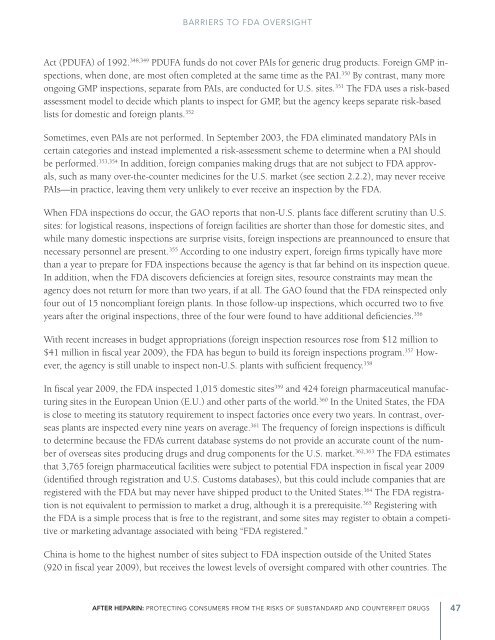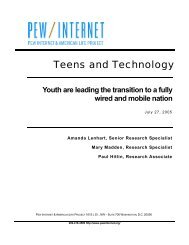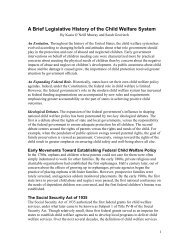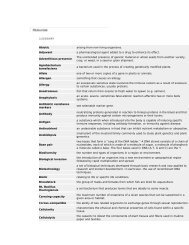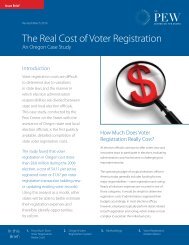After Heparin: - The Pew Charitable Trusts
After Heparin: - The Pew Charitable Trusts
After Heparin: - The Pew Charitable Trusts
You also want an ePaper? Increase the reach of your titles
YUMPU automatically turns print PDFs into web optimized ePapers that Google loves.
BARRIERS TO FDA OVERSIGHT<br />
Act (PDUFA) of 1992. 348,349 PDUFA funds do not cover PAIs for generic drug products. Foreign GMP inspections,<br />
when done, are most often completed at the same time as the PAI. 350 By contrast, many more<br />
ongoing GMP inspections, separate from PAIs, are conducted for U.S. sites. 351 <strong>The</strong> FDA uses a risk-based<br />
assessment model to decide which plants to inspect for GMP, but the agency keeps separate risk-based<br />
lists for domestic and foreign plants. 352<br />
Sometimes, even PAIs are not performed. In September 2003, the FDA eliminated mandatory PAIs in<br />
certain categories and instead implemented a risk-assessment scheme to determine when a PAI should<br />
be performed. 353,354 In addition, foreign companies making drugs that are not subject to FDA approvals,<br />
such as many over-the-counter medicines for the U.S. market (see section 2.2.2), may never receive<br />
PAIs—in practice, leaving them very unlikely to ever receive an inspection by the FDA.<br />
When FDA inspections do occur, the GAO reports that non-U.S. plants face different scrutiny than U.S.<br />
sites: for logistical reasons, inspections of foreign facilities are shorter than those for domestic sites, and<br />
while many domestic inspections are surprise visits, foreign inspections are preannounced to ensure that<br />
necessary personnel are present. 355 According to one industry expert, foreign firms typically have more<br />
than a year to prepare for FDA inspections because the agency is that far behind on its inspection queue.<br />
In addition, when the FDA discovers deficiencies at foreign sites, resource constraints may mean the<br />
agency does not return for more than two years, if at all. <strong>The</strong> GAO found that the FDA reinspected only<br />
four out of 15 noncompliant foreign plants. In those follow-up inspections, which occurred two to five<br />
years after the original inspections, three of the four were found to have additional deficiencies. 356<br />
With recent increases in budget appropriations (foreign inspection resources rose from $12 million to<br />
$41 million in fiscal year 2009), the FDA has begun to build its foreign inspections program. 357 However,<br />
the agency is still unable to inspect non-U.S. plants with sufficient frequency. 358<br />
In fiscal year 2009, the FDA inspected 1,015 domestic sites 359 and 424 foreign pharmaceutical manufacturing<br />
sites in the European Union (E.U.) and other parts of the world. 360 In the United States, the FDA<br />
is close to meeting its statutory requirement to inspect factories once every two years. In contrast, overseas<br />
plants are inspected every nine years on average. 361 <strong>The</strong> frequency of foreign inspections is difficult<br />
to determine because the FDA’s current database systems do not provide an accurate count of the number<br />
of overseas sites producing drugs and drug components for the U.S. market. 362,363 <strong>The</strong> FDA estimates<br />
that 3,765 foreign pharmaceutical facilities were subject to potential FDA inspection in fiscal year 2009<br />
(identified through registration and U.S. Customs databases), but this could include companies that are<br />
registered with the FDA but may never have shipped product to the United States. 364 <strong>The</strong> FDA registration<br />
is not equivalent to permission to market a drug, although it is a prerequisite. 365 Registering with<br />
the FDA is a simple process that is free to the registrant, and some sites may register to obtain a competitive<br />
or marketing advantage associated with being “FDA registered.”<br />
China is home to the highest number of sites subject to FDA inspection outside of the United States<br />
(920 in fiscal year 2009), but receives the lowest levels of oversight compared with other countries. <strong>The</strong><br />
<strong>After</strong> <strong>Heparin</strong>: PRotecting Consumers from the Risks of Substandard and Counterfeit Drugs 47


